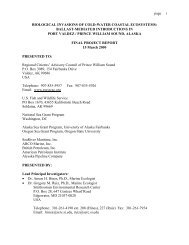Harmful Non-Indigenous Species in the United States - Aquatic ...
Harmful Non-Indigenous Species in the United States - Aquatic ...
Harmful Non-Indigenous Species in the United States - Aquatic ...
Create successful ePaper yourself
Turn your PDF publications into a flip-book with our unique Google optimized e-Paper software.
14 I <strong>Harmful</strong> <strong>Non</strong>-<strong>Indigenous</strong> <strong>Species</strong> <strong>in</strong> <strong>the</strong> <strong>United</strong> <strong>States</strong>Table 1-7—Basic Legal Approaches Used by <strong>States</strong> for Fish and Wildlife Importation and ReleaseImportation a bBasic approach Number <strong>States</strong> Number <strong>States</strong>All species are prohibited unless onallowed (“clean”) list(s).All species may be allowed exceptthose on prohibited (“dirty”) list(s).Prohibited list(s) have 5 or moreidentified species or groups.Prohibited list(s) have fewer than 5identified species or groups.All species may be allowed; <strong>the</strong>re is noprohibited list.2 + 1 pt c Hl, IDpt, VT d20 + 3pt AL, AR, CO, CT, FL, IL, KS,KY, Ml, MN, MTpt, NC, NE,NY, OH, PA, SCpt, SD, TN,TXpt, UT WA, WY11 + 3pt AK, DE, IN, LApt, MD, ME,MS, NH, NV, NJ, ORpt, RI,VA, WVpt11 + 7pt AZ, CA, GA, IDpt, 1A, LApt,MA, MO, MTpt, ND, NH,NM, OK, ORpt, SCpt, TXpt,Wl, WvptRelease1 + 5pt AKpt, FLpt, GApt, Hl, IDpt,KYpt14+ 6pt AL, AR, CO, CT, FLpt, GApt,IL, KS, KYpt, MN, NE, NY,OHpt, PA, SCpt, TN, TXpt,UT WA, WY11 + 6pt AKpt, IN, LApt, NC, NDpt,NJ, MD, MN, MS, NH, NV,OR, Rlpt, SD, VA, VTpt,Wvpt12+ 9pt AZ, CA, DE, IDpt, 1A, LApt,MA, ME, Ml, MO, MT, NDptNM, OHpt, OK, Rlpt, SCpt,TXpt, VTpt, Wl, WVptaState regulation of “possession” of a group or groups is considered here as regulation of both “importation” and “release,” s<strong>in</strong>ce nei<strong>the</strong>r act canbe done without hav<strong>in</strong>g possession. For <strong>the</strong> few <strong>States</strong> that specifically regulate “importation with <strong>in</strong>tention to release (or <strong>in</strong>troduce),” it is not treatedhere as comprehensive regulation of “release” because it covers only acts of importation done with a specific <strong>in</strong>tent.b Many states that regulate importation of particular groups exempt mere transportation through <strong>the</strong> State. These are not dist<strong>in</strong>guished here.CSome <strong>States</strong> treat different groups of vertebrates differently, This is designated, where applicable, by us<strong>in</strong>g <strong>the</strong> abbreviation “pt” after <strong>the</strong> State<strong>in</strong>itial to <strong>in</strong>dicate <strong>the</strong> entry covers only “part” of <strong>the</strong> vertebrates regulated. They are totaled separately.d The summary classifications are general; <strong>in</strong> many states <strong>the</strong>re are limited exemptions, such as for scientific research, and o<strong>the</strong>r m<strong>in</strong>or provisionswhich are not covered here. The extensive State regulation of falconry is excluded.SOURCES: Office of Technology Assessment, 1993 and Center for Wildlife Law, University of New Mexico Law School, “Selected Research andAnalysis of State Lawson Vertebrate Animal Importation and Introduction,” contractor report prepared for <strong>the</strong> Office of Technology Assessment,Wash<strong>in</strong>gton, DC, April 1992.New species played a significant role <strong>in</strong> pastext<strong>in</strong>ctions of <strong>in</strong>digenous species and cont<strong>in</strong>ue todo so. In Florida, several non-<strong>in</strong>digenous aquaticweeds and <strong>in</strong>vasive trees seriously threaten <strong>the</strong>Everglades wetlands system.Hawaii’s isolation makes it most <strong>in</strong> need of acomprehensive policy to address NIS. Differ<strong>in</strong>gFederal and State priorities have made thisdifficult to achieve, however. Cooperative effortshave sprung up <strong>in</strong> both <strong>States</strong> among State andFederal agencies, nongovernmental organizations,agricultural <strong>in</strong>terests, and universities. Increas<strong>in</strong>gly,<strong>the</strong>se groups see harmful NIS as a unify<strong>in</strong>gthreat and public education as an important tool toaddress it. The situation <strong>in</strong> Hawaii and Florida,while unusual <strong>in</strong> some ways, never<strong>the</strong>less heraldswhat o<strong>the</strong>r <strong>States</strong> face as additional harmful NISenter and spread throughout <strong>the</strong> <strong>United</strong> <strong>States</strong> andpeople become more aware of <strong>the</strong>ir damage.For this chapter, OTA commissioned a backgroundpaper on each State and 12 expertsreviewed this work. Two contractors conductedextensive <strong>in</strong>terviews and site visits <strong>in</strong> Hawaii andOTA staff did <strong>the</strong> same <strong>in</strong> Florida. Also, OTAcommissioned a survey and assessment of U.S.environmental education programs.Based on this work, OTA concludes that <strong>the</strong>situation <strong>in</strong> Hawaii and Florida, while unusual<strong>in</strong> some ways, never<strong>the</strong>less heralds what o<strong>the</strong>r<strong>States</strong> face as additional harmful NIS enterand spread throughout <strong>the</strong> <strong>United</strong> <strong>States</strong> andpeople become more aware of <strong>the</strong>ir damage.These results lead to <strong>the</strong> policy options discussedlater <strong>in</strong> this chapter on:














